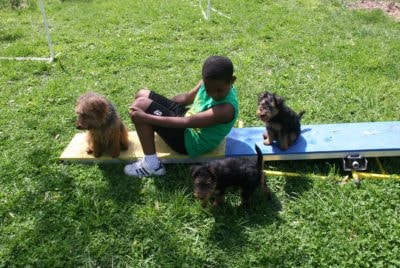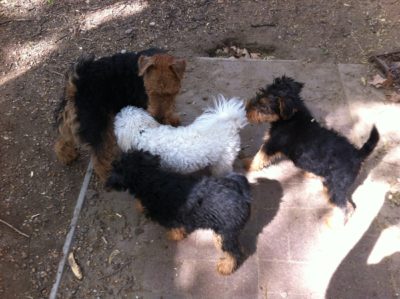Go to Puppies 12 to 16 weeks >
The puppy’s brain is now able to learn as well as an adult (even though the puppy still has the physical limitations of being in an immature body).
An important developmental window closes between 12 and 16 weeks of age. Experiences before that time help shape a puppy’s worldview. It takes a bit of effort during these early weeks to help the puppy see the world as you would like but it takes much more time to change the puppy’s feelings when it is older. Begin training right away – your pup will be learning during every waking moment!
For a puppy who has had a smooth start
- Complete the checklist from First 24 Hours Together. Already past 24 hours? Regroup and start over using the checklist!
- Introduce the puppy to a wide variety of sights, sounds, smells, objects, surfaces, people, dogs, other animals, experiences, and situations using positive association.
- Begin a puppy kindergarten class or a similar process of careful exposures. https://avsab.org/wp-content/uploads/2019/01/Puppy-Socialization-Position-Statement-FINAL.pdf
- Actively plan new experiences for your puppy. A well-structured class will provide a variety of new experiences, including interactions with new people and other puppies of multiple shapes, sizes and personalities. If a class is not available, you will need to be sure to help your puppy meet lots of new people and friendly dogs.
 Help the puppy learn to expect the unexpected. This is the goal of puppy class but it must be continued all week between classes, too. Introduce your puppy to so many new things that she looks forward to the new and different. We want her to see something new, look at you and say, “There’s something different – do I get a treat for this one?” There is no way to go back later and make up for lost time now.
Help the puppy learn to expect the unexpected. This is the goal of puppy class but it must be continued all week between classes, too. Introduce your puppy to so many new things that she looks forward to the new and different. We want her to see something new, look at you and say, “There’s something different – do I get a treat for this one?” There is no way to go back later and make up for lost time now.

- Introduce the puppy to clicker training and practice your own skills.
- List important behaviors for your situation and start them first. Here are some priorities that most people find useful.
- Keep your teeth to yourself (no biting)
- Take treats from hand (accept food as a reinforcer)
- Keep barking to a minimum (stay quiet most of the time)
- Keep front feet on the floor (no jumping or counter surfing)
- Chew nothing but dog toys (allow access to nothing but dog toys)
- Greet strangers politely (keep feet on the ground and mouth closed)
- Wear collar or harness comfortably(ignore when on)
- Accept leash calmly (hold still while attached to collar or harness)
Suggestions for:
For a puppy who has had a rough start
Examples of a rough start include but are not limited to:
- a puppy that was not from a planned litter – because the mother is unlikely to have received the support she needed and the people may not be prepared.
a puppy who was not given individual attention between 3 and 8 weeks -because people were not there or did not understand what puppies need for behavioral health. - a puppy whose experiences were limited or frightening due to injury or illness – because it associated pain or discomfort with people and places without an opportunity to learn new, healthy behaviors.
- a puppy who was taken from its mother before the age of 7 weeks – because it will bond more with people and be uncomfortable around other dogs.
- a puppy who had no littermates – because it will not have learned canine social interactions from its littermates.
- a puppy whose mother was not in good health – because she may not be up to the work involved in being a good mother, either in providing nutrition or in teaching life lessons.
- a puppy whose mother was not comfortable around people – because the mother will not be helpful in teaching the pup to be confident around people.
- a puppy who stayed with its littermates after the age of 8 weeks – because it will have bonded more to its littermates and be less likely to form attachments to people.
Provide everything as suggested for a puppy with a smooth start, then pay special attention to the following:
- Complete the checklist from First 24 Hours Together. Already past 24 hours? Regroup and start over using the checklist!
- Wait for the dog to sit (or any behavior of your choice) before giving attention so that it can learn how to manipulate its environment through two-way communication
- Introduce practical handling experiences so that it readily accepts handling of ears and feet and gentle restraint. Let your dog know what to expect. Teach your dog that you will be respectful and handling can be a positive experience.
Teach your young puppy to accept holding and handling so that it will not be surprised or worried when it is restrained by a veterinarian or groomer – or even you when you need to examine a sore paw or give a bath.
Teach your dog to allow you to lay it on its side using the following plan, with the understanding that some pups my not need as many steps and some may need more:
- Use a treat to draw the pup to your side
- Put an arm around the pup and hold firmly against your side
- Hold firmly and grasp front elbow nearest handler’s body
- Hold firmly and slide pup’s rear to floor
- Hold firmly, slide pup’s rear, then front, to floor
- Hold firmly, slide pup all the way to floor and hold there
- Increase duration by increasing the average time you expect the pup to hold still, while always including some very short times
Practice each step several times if necessary, moving to the next only when the pup is comfortable with the current stage. Expect progress to be fast. Many pups will master all the steps within five minutes.
- At the end of each hold release the pup and give a treat.
- Because both hands will be used on the pup, it will be difficult to click. A different marker that the pup understands (I make a “T’ sound as in “Tuh.”) may be used. Mark during the hold in order to reinforce it, then release and treat.
- The release may also serve as a reinforcer.